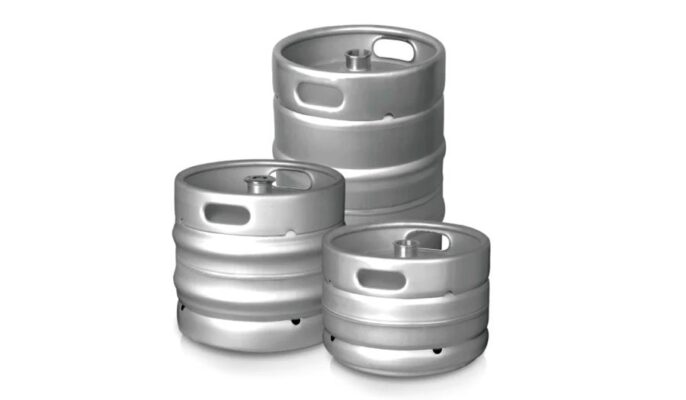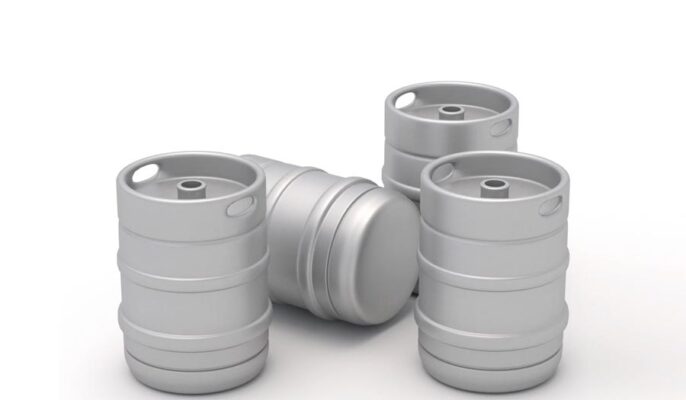Beer kegs come in different types and sizes, depending on how, where, and who uses them. Understanding the differences between beer keg sizes can help you make the right choice. Although stainless steel kegs for modern breweries come in a variety of sizes, they all originate from a historical American system of measuring liquid volume called a “bucket.”
What is a beer keg?
Beer kegs are made of stainless steel. Modern single-valve (sometimes called Sankey) kegs have an opening in the top. A tube called a “spear” extends from the top of the barrel to the bottom. There is a sump or shallow well at the bottom to ensure that as much beer as possible is emptied from the barrel. The self-closing valve at the top opens via the barrel connector.
Most U.S. breweries sell beer in 1/2 barrels for 15.5 gallons, 1/4 barrels for 7.75 gallons, and 1/6 barrels for 5.17 gallons. In the United States, the terms “half barrel” and “quarter barrel” are derived from American beer barrels that are defined as equal to 31 US gallons.

Beer barrel components
Tap and Faucet
The spigot and spigot are the most obvious components of the keg. They are used to dispense beer from kegs. The tap or beer coupler connects to the keg valve, while the tap stem connects to the tap handle. The valve keeps the beer inside the keg, while the tap stem and spigot allow the beer to flow. Keg faucets come in different types, including Sankey connectors and keg connectors. Faucet levers are usually made of brass or stainless steel and have levers that control the flow of beer.
Beer production lines and seals
Beer lines and seals are used to transport beer from the keg to the draft beer tap. The draft beer tap line is the tube that connects the draft beer tap back to the keg. The line is usually made from food-grade plastic or vinyl. Seals are used to prevent leaks and maintain pressure within the barrel. They are usually made of rubber or silicone and are placed between the various parts of the keg.
Spear and dip tube
Spears and dip tubes are used to pull and dispense beer from the barrel. A spear is a metal tube inserted into the keg and used to pull and inject gas into the keg. The dip tube is a metal tube that extends from the spear to the bottom of the keg. It is used to draw beer from the barrel and transport it to the beer production line.
Beer barrel materials and structure
Kegs are made of stainless steel, making them durable, corrosion-resistant, and easy to clean. The barrel shell is the most important part of the barrel and is usually made of two layers of stainless steel. The inner layer is polished to a mirror finish to prevent contamination, while the outer layer is insulated to keep the beer cold. The keg also has a lid that is sealed with a gasket to prevent leaks. The lid has a pressure relief valve to vent excess pressure and air.
Types of beer barrels
There are three types of kegs available. There are ball lock barrels, pin lock barrels, and Sankey barrels. Ball locks and pin locks are very similar, but they have subtle differences that set them apart. Sankey kegs are most used in commercial breweries, but home brewers can also use them.
Ball lock keg
These are the most common kegs found in home breweries. They use “ball locks” (hence the name) to connect gas and liquid lines. When purchasing a disconnect for these kegs, be sure to buy the correct one (their description will include a ball lock). Ball lock kegs are taller and slimmer than pin lock kegs.
Pin lock keg
These are very like ball lock kegs. In some cases, pin-lock keg lids do not have manual pressure relief valves (PRVs), but replacement lids for home breweries often include them. Pin locks are used in different forms to protect gas and liquid disconnections. This feature makes it impossible to confuse which end is for gases and which is for liquids.
Sankey Keg
Sankey Keg is the weirder one of the bunch. They have only one port (located in the center of the keg) that feeds gas in and liquid out in the same device (called a coupler). They do need more work to disassemble but are less prone to gas leaks since there are fewer potential gas escape points. Sankey barrels are used by commercial breweries, but they are becoming popular among home breweries.

Běžný barrel equipment systems
Kegging equipment is essential for the storage, distribution, and transportation of draft beer. From kegging machines to CO2 tanks and regulators, many components make up a good draft system kegging setup.
Keg and draft beer systems
A kegerator is a refrigerator designed to hold a keg of beer and dispense it through a two-tap system. This is an excellent choice for homebrewers who want to enjoy draft beer without the hassle of bottling. Keggers come with a drip tray, CO2 tank, regulator, and beer lines. It’s important to choose a kegerator that fits your keg size and has the necessary features to meet your draft beer dispensing needs.
CO2 tank and regulator
CO2 tanks, accessories, and regulators are essential accessories for carbonating and dispensing keg beer. The CO2 tank is filled with compressed gas that is used to push it out of the barrel. The regulator controls the flow and pressure of gas, thereby affecting the carbonation and dispensing of the beer. It is important to choose a regulator that is compatible with your CO2 tank and has the necessary features to meet your needs.
Hand pumps and dispensers
Hand pumps and dispensers are alternatives to CO2 tanks and regulators. They use air pressure to dispense beer from the keg, which makes them ideal for outdoor events or situations where electricity is not available. Hand pumps need pumping beer, which can be tiring and affect the quality of your beer. A more convenient option is a dispenser, which uses a can of pressurized air to dispense beer.
Beer on tap
Beer kegs are a popular choice among brewpub enthusiasts when it comes to serving beer. They’re durable, portable, and can hold a lot of beer. In this section, we’ll discuss the different types of beer and beverages that can be sold in beer kegs, the importance of beer taps and lines in a brewpub, and how flavor and quality are affected.
Maintain your beer keg
To ensure the longevity of your beer keg, preventing leaks and maintaining pressure is crucial. The first step to preventing leaks is to check the airtight seal between the keg and keg connector. This seal must be tight to prevent any leakage. If a leak occurs, it may be due to a faulty gasket or barrel connector. Any damaged gasket or keg connector must be replaced immediately to prevent beer wastage.
- Cleaning and Maintenance: Keeping your beer keg clean is essential to prevent the build-up of bacteria or unwanted flavors. cleaning and sanitizing your keg and its components will ensure your beer tastes fresh and delicious. It is recommended to clean your keg after each use.
- Troubleshooting: If you encounter any problems with your beer keg, such as slow beer flow or excessive foam, there are a few things you can check. First, make sure the keg is pressurized and the CO2 tank is not empty. If the pressure is correct, check the beer tap, handle, and keg connector for any damage or blockage.




